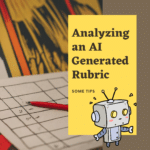Guest Post by Victoria Thompson

Today I’d like to take the time to talk about one of my favorite Microsoft tools: Immersive Reader. I’m a huge fan of Immersive Reader, Microsoft’s premier tool to increase readability of content. I mainly use it in OneNote. From using it with the teachers I work with to teaching my own mother how to use the tool (and she is also a fan!), I just don’t see how I can function at my workplace and in my personal life without it.
I’m often asked what Immersive Reader over other tools has; specifically, what gives Immersive Reader an edge in education. Here are my top three reasons:
- You can select the reading speed. In Immersive Reader there is an option for your words to be read aloud to you, and you can actually select the reading speed that you’d like for it to be rad aloud. This may seem arbitrary, but I can’t express enough how wonderful it is to be able to select your reading speed and also to select it in a way that doesn’t create finite speeds. If that’s confusing, let me explain: Immersive Reader has reading speeds on a sliding scale from a picture of a literal turtle (slowest) to a picture of a rabbit (fastest). There is no “1, 2, 3, etc” scale that ranks the speeds and you can adjust throughout the course of the read aloud as well. There’s something about this that’s so creative that I love.
- Integration with Picture Dictionary. Picture Dictionary is a feature in Immersive Reader that allows for a viewer to see a picture and hear a word simultaneously. To use Picture Dictionary in Immersive Reader, first make sure that it’s on by going to “Reading Preferences” and turning the toggle to “on.” Then, all that you have to do is select a word to see the Picture Dictionary definition of that word. Select the speaker icon next to the word to hear it read aloud. I’ve found this extremely helpful for English Language Learners. The one catch is that Picture Dictionary doesn’t work for *all* words in Immersive Reader—for example, if I select the word “is,” nothing will show up. However, if I select the word “watermelon,” a picture of a watermelon will appear. As a former math educator and current STEM coach, I’ve used Picture Dictionary in Immersive Reader with my students who struggle with decoding word problems. I have a video that talks about it here.
3. Highlights of Parts of Speech. I’ve mentioned this before in a previous blog post, but Immersive Reader actually gives you the opportunity to analyze parts of speech. You can specifically single out verbs, nouns, adjectives, and adverbs, and even assign colors and labels to them.
When using Immersive Reader, consider giving these concepts tips a try. I’ve used them primarily for math and STEM classes but I’ve seen teachers do wonderful things with it in ELA, social studies, and even physical education!
About the Author
Victoria Thompson is a STEM Integration Transformation Coach at Technology Access Foundation–a nonprofit leader redefining STEM education in public schools–and a consultant for Ignite EdTech. She has been in education for five years and began her journey teaching fifth and sixth grade math and science in Summerville, SC. After completing her masters degree in curriculum and instruction she moved to the Seattle, WA area in 2018, where her career has pivoted to focusing on STEM integration in schools, K-12 mathematics instruction with research on decolonizing mathematics curriculum for teachers and learners, creating inclusive math environments, and using technology to bridge equity gaps in math education.








